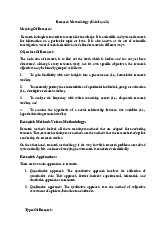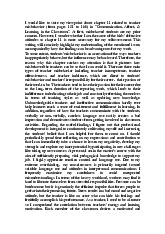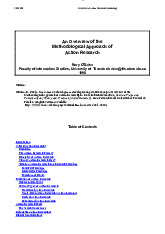


Preview text:
lOMoAR cPSD| 58097008
Name: Huỳnh Nguyễn Gia Hân Student number: B2206529 Group: M01 Order number: 21
RESEARCH METHODOLOGY FOR INTERNATIONAL BUSINESS
1. Summarize briefly literature
While the specific section labeled "Literature Review" may not be explicitly stated,
the relevant content can be inferred from the discussions on the theoretical
background and the references to prior studies throughout the text, particularly in
sections discussing the methodology and findings.
The literature review in the article on the impact of e-service quality and customer
satisfaction on customer behavior in online shopping provides a comprehensive
overview of existing research related to e-service quality, customer satisfaction, and
their effects on consumer behavior. It begins by defining e-service quality, which is
crucial in the context of online shopping, where customers rely heavily on digital
interfaces to make purchasing decisions. The review highlights various models and
frameworks that have been developed to measure e-service quality, with a particular
focus on the four dimensions identified by Blut et al. (2015): website design,
security/privacy, fulfillment, and customer service.
Website design is emphasized as a critical factor that influences user experience and
satisfaction. A well-structured and visually appealing website can enhance navigation
and ease of use, leading to a more positive shopping experience. The literature
suggests that elements such as layout, content clarity, and aesthetic appeal play
significant roles in shaping customer perceptions of e-service quality.
Security and privacy are also highlighted as paramount concerns for online
consumers. The review discusses how customers are increasingly aware of the risks
associated with online transactions, including data breaches and identity theft. As a
result, businesses that prioritize security measures and communicate these effectively
to customers can build trust and enhance customer satisfaction. The literature
indicates that perceived security positively correlates with customer trust, which is
essential for encouraging repeat purchases and fostering loyalty.
Fulfillment, which encompasses order accuracy, timely delivery, and product
availability, is another critical dimension of e-service quality. The review notes that lOMoAR cPSD| 58097008
customers expect their orders to be fulfilled as promised, and any discrepancies can
lead to dissatisfaction and negative word-of-mouth. Research indicates that effective
fulfillment processes not only enhance customer satisfaction but also contribute to a
positive overall perception of the online retailer.
Customer service, while identified as a significant dimension of e-service quality, is
noted in the literature as having a less direct impact on overall e-service quality
compared to the other three dimensions. The review suggests that while responsive
and helpful customer service can enhance the shopping experience, it may not be as
critical as website design, security, and fulfillment in influencing customer satisfaction and behavior.
The literature review also explores the relationship between customer satisfaction and
customer behavior, particularly in the context of online shopping. It highlights that
satisfied customers are more likely to exhibit positive behaviors, such as repurchase
intentions and recommending the retailer to others. The review cites studies that
demonstrate a strong link between customer satisfaction and word-of-mouth (WOM)
recommendations, indicating that satisfied customers often share their positive
experiences with friends and family, further driving customer acquisition.
Additionally, the review discusses the role of customer trust in the online shopping
environment. Trust is identified as a crucial factor that influences customer decisions,
especially in situations where customers cannot physically inspect products before
purchase. The literature suggests that trust can mitigate perceived risks associated
with online shopping, leading to increased customer loyalty and repeat purchases. The
review emphasizes that building trust requires consistent delivery of high-quality
service and transparent communication regarding security and privacy practices.
The review also acknowledges the importance of cultural context in shaping consumer
perceptions of e-service quality. It suggests that cultural differences can influence how
customers evaluate service quality attributes, which has implications for businesses
operating in diverse markets. The literature indicates that understanding local
consumer behavior and preferences is essential for tailoring e-service quality
strategies to meet specific market needs.
In summary, the literature review provides a thorough examination of the key
dimensions of e-service quality and their impact on customer satisfaction and
behavior in online shopping. It highlights the importance of website design,
security/privacy, fulfillment, and customer service in shaping customer perceptions
and experiences. The review also underscores the critical roles of customer
satisfaction and trust in driving positive consumer behaviors, such as repurchase
intentions and WOM recommendations. Furthermore, it emphasizes the need for
businesses to consider cultural differences when assessing e-service quality,
suggesting that a one-size-fitsall approach may not be effective in diverse markets.
Overall, the literature review sets the foundation for the study's research objectives lOMoAR cPSD| 58097008
and hypotheses, aiming to contribute to the understanding of e-service quality in the context of online shopping.
2. What can you learn from the article?
From the article examining the impact of e-service quality on customer satisfaction
and behavior in online shopping, I can learn about the critical dimensions that shape
the online shopping experience and influence consumer decisions. The study identifies
four key dimensions of e-service quality: website design, security/privacy, fulfillment,
and customer service. It emphasizes that website design is paramount, as it
encompasses usability, aesthetics, and the overall customer experience on the site. A
well-designed website not only attracts customers but also facilitates easier navigation
and enhances the purchasing process, which is crucial for retaining customers in a
competitive online marketplace. Security and privacy are highlighted as essential
factors that build customer trust; consumers are increasingly concerned about the
safety of their personal information during online transactions. The article underscores
that effective communication of security measures can significantly enhance customer
confidence, leading to higher satisfaction levels. Fulfillment is another critical
dimension, as it relates to the accuracy and timeliness of order delivery. Customers
expect their orders to be fulfilled as promised, and any failure in this area can lead to
dissatisfaction and negative perceptions of the retailer. Interestingly, the study finds
that customer service, while important, does not have as strong an impact on overall
eservice quality as the other dimensions, suggesting that customers may not always
require extensive support during every transaction. The article also explores the
relationship between customer satisfaction and behavior, revealing that satisfied
customers are more likely to exhibit positive behaviors such as repurchase intentions
and word-of-mouth recommendations. This highlights the importance of not only
meeting but exceeding customer expectations to foster loyalty and encourage positive
referrals. Additionally, the research emphasizes the role of cultural context,
particularly in Indonesia, indicating that consumer perceptions of e-service quality can
vary significantly across different cultural settings. This insight is vital for businesses
operating in diverse markets, as it encourages them to tailor their strategies to local
consumer preferences. Overall, the article provides valuable insights for online
retailers, guiding them in enhancing their service quality to improve customer
satisfaction and drive positive consumer behavior, ultimately contributing to longterm business success.




